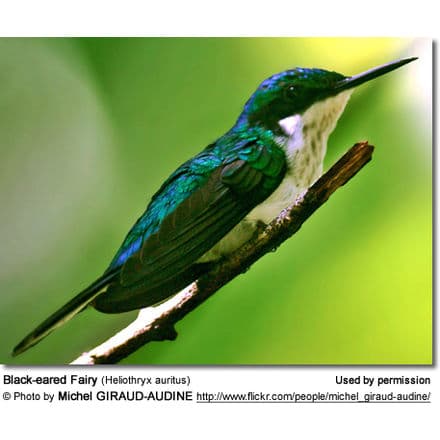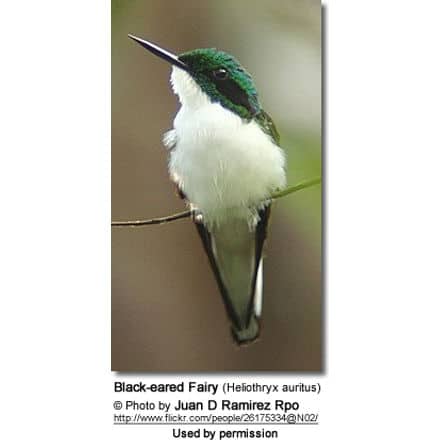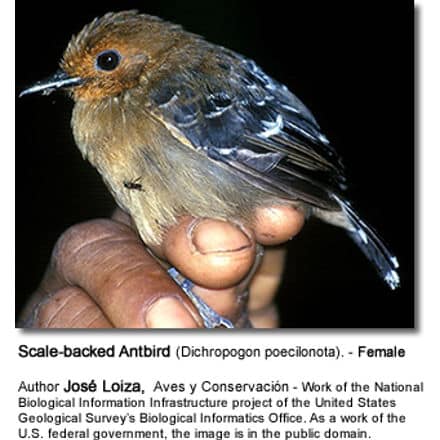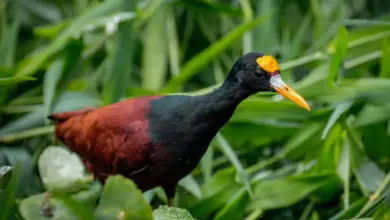Black-eared Fairy or Green-chinned Fairy
The Black-eared Fairy or Green-chinned Fairy Black-eared Fairy is a South American hummingbird that occurs naturally in the Amazon rainforest with a disjunct population in eastern Brazil.
Alternate (Global) Names
Spanish: Colibrí Hada de Orejas Azules, Colibrí Hada Oriental, Hada Oriental … Portuguese: Beija-flor-de-bochecha-azul, beija-flor-fada … French: Colibri oreillard …Italian: Capello di sole orecchie nere, Fatina guancenere … German: Schwarzohr-Schmuckkolibri … German: Schwarzohrelfe, Schwarzohr-Schmuckkolibri … Czech: kolib?ík ?ernouchý, Kolibrík zlatovlasý … Danish: Sortøret Alfekolibri … Finnish: Viherkeijukolibri … Japanese: mimigurosennyohachidori … Latin: Heliothryx aurita, Heliothryx auritus … Dutch: Zwartkopfeeënkolibrie, Zwartkop-feeünkolibrie … Norwegian: Grønnkronealv … Polish: skrzacik czarnouchy … Portuguese: Baija-flor-de-bochecha-azul, beija-flor-de-bochecha-azul, Beija-flor-fada …Russian: ??????? ???????, ????????? ???????-???, ????????? ??????? ??????? … Slovak: jagavicka bielobruchá, Kolibrík ?iernopásikavý … Swedish: Svartkindad blomnymf
Distribution / Habitat
The Black-eared Fairy is native to the following South American countries: Bolivia, Brazil, Colombia, Ecuador, French Guiana, Guyana, Peru, Suriname and Venezuela.
They are mostly found in or near humid lowland forests.
Subspecies and Distribution
- Heliothryx auritus auritus (J. F. Gmelin, 1788) – Nominate Race
- Found in the tropical south-eastern Colombia to Venezuela, the Guianas and northern Brazil
- Heliothryx auritus auriculata / auriculatus (Nordmann, 1835)
- Found in tropical eastern Peru, Bolivia to central and eastern Brazil (Amazonia south of Amazon through Mato Grosso to Alagoas and Bahia, and south to Espírito Santo, vagrant to Santa Catarina).
- Found in north central Brazil south of Amazon in the Brazilian states of Pará and Maranhão
Description
This medium-sized hummingbird has as bright green upper plumage and is white below. It has a black face mask. Its black bill is short and straight. The tail is blue-back in the center with white outer tail feathers. When perched, the tail looks mostly white from below and blue-black from the back or above.
The female looks similar, but has a longer tail.
Similar Species: They resemble the Purple-crowned Fairy found in southeastern Mexico south to southwestern Ecuador. However, the male of that species has a purple crown. Females of either species are identifical. However, since these two species don’t overlap in distribution, identification is usually not a problem.
Hummingbird Resources
- Hummingbird Information
- Hummingbird Amazing Facts
- Attracting Hummingbirds to Your Garden
- Hummingbird Species
- Feeding Hummingbirds
Nesting / Breeding
Hummingbirds are solitary in all aspects of life other than breeding; and the male’s only involvement in the reproductive process is the actual mating with the female. They neither live nor migrate in flocks; and there is no pair bond for this species.
Males court females by flying in a u-shaped pattern in front of them. He will separate from the female immediately after copulation. One male may mate with several females. In all likelihood, the female will also mate with several males. The males do not participate in choosing the nest location, building the nest or raising the chicks.
Hummingbird Information


Diet / Feeding
The Black-eared Fairies primarily feed on nectar taken from a variety of brightly colored, scented small flowers of trees, herbs, shrubs and epiphytes. They favor flowers with the highest sugar content (often red-colored and tubular-shaped) and seek out, and aggressively protect, those areas containing flowers with high energy nectar.



